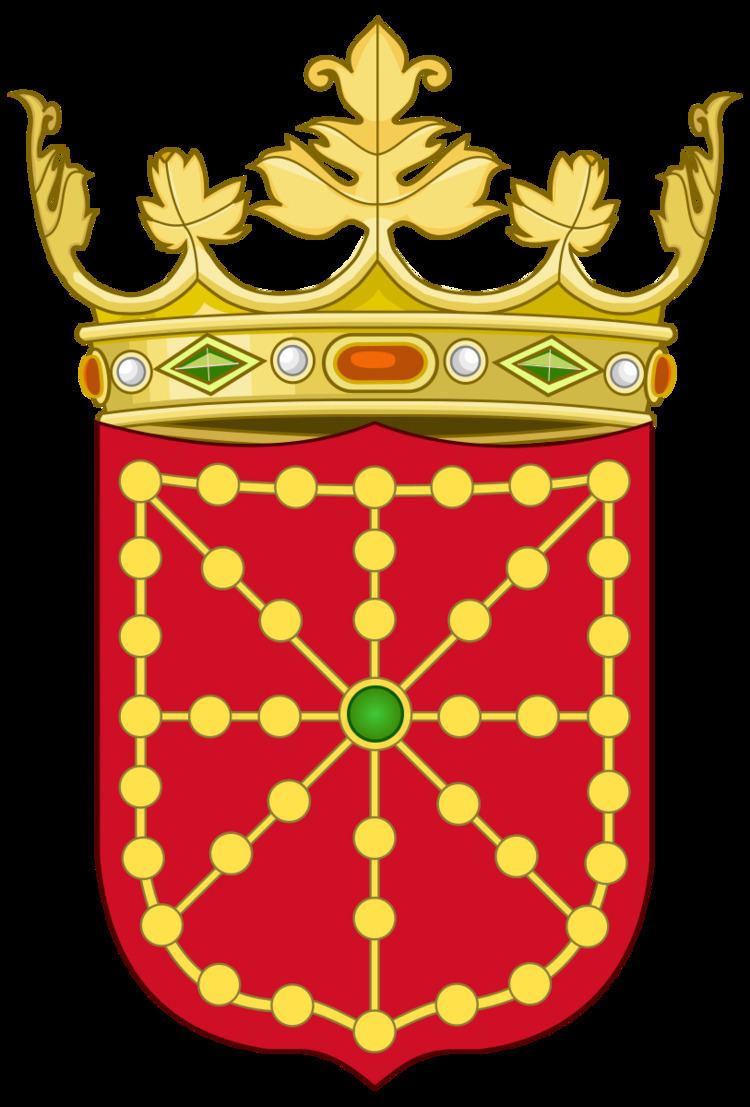 | ||
This is a list of the kings and queens of Pamplona, later Navarre. Pamplona was the primary name of the kingdom until its union with Aragon (1076–1134). However, the territorial designation Navarre came into use as an alternative name in the late tenth century, and the name Pamplona was retained well into the twelfth century.
Contents
House of Íñiguez, ? 824–905
The Íñiguez dynasty founded the Navarrese kingdom (of Pamplona) in or around 824 when they rebelled against nominal Frankish (Carolingian) authority.
House of Jiménez, 905–1234
In 905, a coalition of neighbors forced Fortún Garcés to retire to a monastery, and enthroned in his place a scion of a new dynasty. Under their reign, the name Navarre began to supplant that of Pamplona.
With the assassination of Sancho IV, Navarre was partitioned by his cousins Alfonso VI of Castile and Sancho Ramirez of Aragon, and the latter made king, leading to more than half-a-century of Aragonese control.
The death of Alfonso led to a succession crisis in Aragon, and the nobles of Navarre took advantage to reestablish an independent monarchy, crowning a grandnephew (through an illegitimate brother) of the assassinated Sancho IV.
House of Champagne, 1234–1284
The death of Sancho VII, the last of the Jimenez kings, led to the crown of Navarre being inherited by the son of his sister Blanche, Countess of Champagne, she having been regent during much of her brother's reign.
House of Capet, 1284–1349
Henry's unexpected death left his infant daughter Joan as the only heir to the throne. Joan's mother Blanche of Artois served as regent for the next ten years. In 1284 Joan was married to the future Philip IV of France, ending Blanche's regency. Philip assumed the throne of France a year later as "King of France and Navarre".
House of Évreux, 1328–1441
After the deaths of Louis and his infant son John, his brothers Philip and Charles held the crowns of France and Navarre until their own deaths. At that time, the crown of France passed to Philip of Valois, a distant cousin who was not descended from Joan I, and the crown of Navarre was allowed to pass to Louis' daughter Joan II. Joan reigned together with her husband Philip III until his death, and then alone until her own death.
House of Trastámara, 1425–1479
Blanche (I) reigned together with her husband John II. In 1458, John additionally inherited the crown of Aragon from his older brother; after his death, the Navarrese crown was given to Eleanor, the only living child of him and Blanche, while his Aragonese crown was given to Ferdinand II of Aragon, son of John and his second wife Juana Enríquez.
Titular King and Queen of Navarre
After Blanche's death in 1441, John retained the crown of Navarre for himself until he died 38 years later, keeping it from his son and elder daughter, Charles and Blanche. Conflict with his son led to the Navarrese Civil War. Though some of the resources regard Charles and Blanche and the legitimate monarchs, the de facto king of Navarre is still John II. Eleanor didn't claim to be the queen until her father's death.
House of Foix, 1479–1517
Eleanor, who had allied with her father against her brother and sister, outlived her father by only three weeks. By that time she was the widow of Gaston IV, Count of Foix, and their oldest son Gaston of Foix, Prince of Viana had also died. She was thus succeeded by her grandson Francis.
House of Albret, 1484–1572
Catherine reigned together with her husband John III. After his death, she reigned alone for 8 months until her own death. During their reign, Navarre was defeated by Ferdinand II of Aragon in 1512, resulting in the loss of all its territory south of the Pyrenees, including the royal capital of Pamplona. Ferdinand, the son of John II and his second wife and thus the half-brother of Catherine's grandmother Eleanor, was then crowned King of Navarre, and that branch of the title descended through the Aragonese and Spanish monarchs. Catherine and John III were left with Lower Navarre, that small fraction of the kingdom's former territory that is on the north side of the Pyrenees, which was united with other lands in France that were under their control.
House of Bourbon, 1572–1620
Jeanne III reigned together with her husband Antoine until his death, and then alone until her own death. Their son Henry became King of France in 1589, taking possession of the kingdom in 1593 as the French Wars of Religion came to a close. Thereafter the crown of Navarre passed to the kings of France. In 1620, the Kingdom was merged into France; however, the French kings continued to use the title King of Navarre until 1791, and it was revived again from 1814 to 1830 during the Bourbon Restoration.
